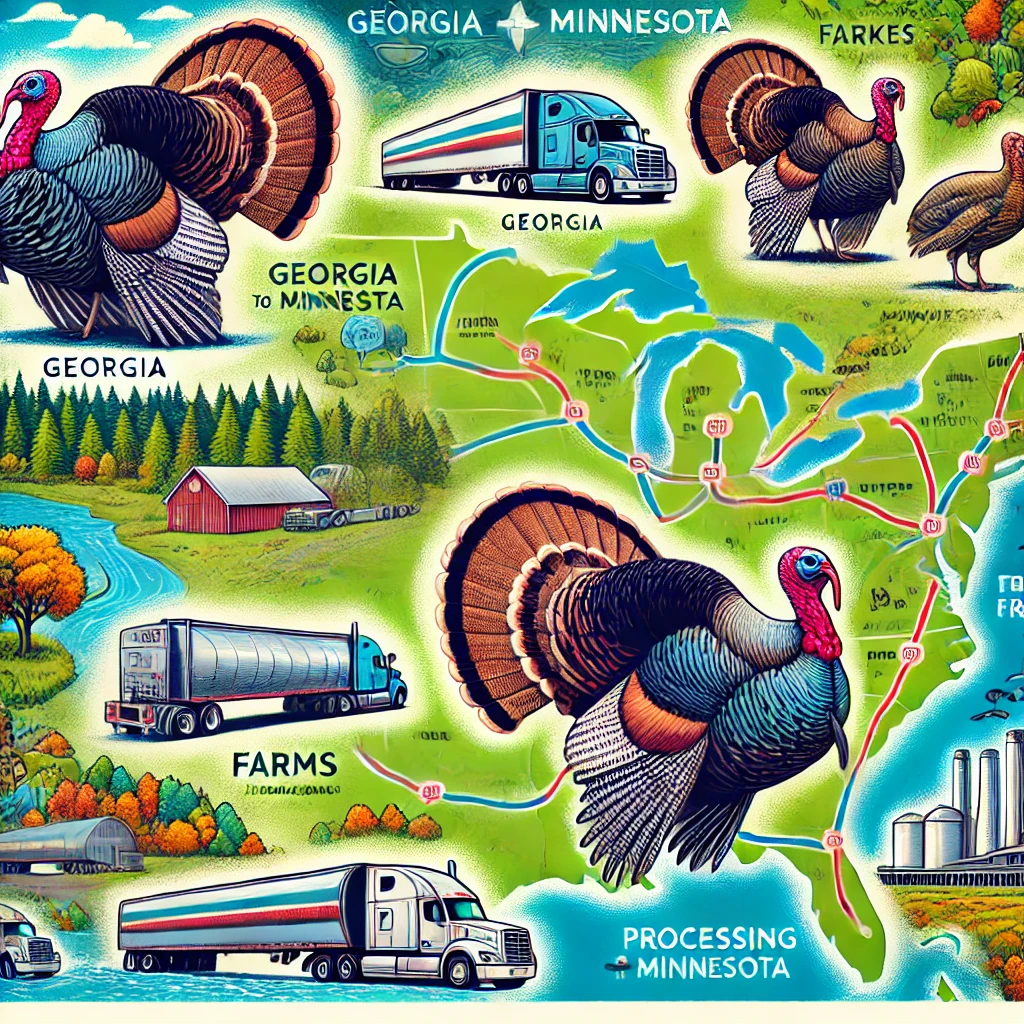The movement of turkeys between Georgia and Minnesota encapsulates a fascinating journey through wild turkey conservation, commercial farming, and the intricacies of agricultural trade routes. Both wild turkeys and farm-raised poultry contribute to this dynamic, with implications for local economies, agricultural practices, and environmental sustainability. This article delves into the different facets of turkey movement, focusing on habitat, industry, transportation, and conservation.
How Does Turkey Go from Georgia to Minnesota: Wild Turkey Habitats and Conservation
Georgia is a haven for the Eastern Wild Turkey, flourishing in diverse settings such as forests, farmlands, and wetlands. Unlike their migratory avian counterparts, wild turkeys are largely sedentary, their movements dictated by food availability and seasonal changes rather than long-distance travel. Minnesota, with its harsher winters and initially scarce food sources, was unsuitable for wild turkeys until reintroduction efforts in the 1970s brought them back. These efforts have led to a thriving population in the southern and central parts of the state, adapting to local woodlands and open fields.
Conservation efforts have played a crucial role in expanding the geographic range of wild turkeys. Organizations like the National Wild Turkey Federation have implemented programs focusing on habitat restoration, hunting regulations, and ongoing population management, ensuring the birds’ survival and adaptability in varied environments.
How Does Turkey Go from Georgia to Minnesota: The Journey of Farm-Raised Turkeys
The commercial journey of turkeys from Georgia to Minnesota is a testament to meticulous planning and logistics in the poultry industry. The process begins in Georgia, where farms breed and hatch turkeys. Workers nurture young turkeys, known as poults, in controlled farm environments until they are ready for transport to Minnesota, the largest turkey-producing state in the U.S.
Managers carefully oversee transportation to ensure the well-being of the turkeys, using specially designed trucks equipped with ventilation, temperature control, and adequate space. This system minimizes stress and maintains health during the transit, which might also involve rail or air shipping for large-scale movements.
How Does Turkey Go from Georgia to Minnesota: Economic and Industrial Impact
Advanced farming techniques, extensive processing facilities, and a robust consumer market drive Minnesota’s prominence in turkey production. Annually, the state processes over 40 million turkeys, significantly contributing to its economy. Major players in the industry, such as Jennie-O Turkey Store and Hormel Foods, are based in Minnesota, leveraging the state’s favorable conditions to meet nationwide demand.
In contrast, Georgia’s poultry industry, predominantly known for chickens, also supplies vital resources to turkey production, including hatchlings, feed, and equipment. This interdependence illustrates the complex network within the U.S. poultry industry, with different states specializing in various production stages.
Environmental Considerations and Sustainable Practices
The turkey industry, though economically significant, faces challenges related to sustainability, such as carbon emissions, water usage, and waste management. The long-distance transport of turkeys contributes to greenhouse gas emissions, prompting some companies to seek solutions in renewable energy, efficient farming techniques, and improved transportation methods.
Furthermore, maintaining the natural habitats of wild turkeys is crucial. Sustainable practices like rotational grazing, reforestation, and pollution control help balance commercial production needs with environmental stewardship. These efforts ensure the viability of turkey farming while protecting ecosystems.
Efficient Logistics: The Backbone of Turkey Transportation
- Streamlined Supply Chains: The turkey industry relies on a well-oiled logistics network to transport turkeys from the farms of Georgia to the processing plants in Minnesota. This network is critical in maintaining the freshness and quality of the poultry during transit.
- Advanced Transportation Technology: Trucks transporting turkeys use state-of-the-art technology for temperature control and ventilation, ensuring the turkeys remain stress-free and healthy throughout their journey.
- Regulatory Compliance: Transportation also adheres to strict regulations regarding animal welfare and food safety, which govern everything from the spacing and feeding of turkeys to the sanitation of transport vehicles.
Economic Contributions: Turkeys Fueling Local Economies
- Job Creation: The turkey industry is a significant employer in both Georgia and Minnesota, providing thousands of jobs in farming, transportation, and processing sectors.
- Revenue Generation: Beyond job creation, turkey production and processing are pivotal in generating substantial revenue for the local economies, especially in Minnesota, where the industry is one of the largest contributors to the agricultural sector.
- Infrastructure Development: The economic impact extends to infrastructure development, with investments in roads, storage facilities, and advanced farming technologies that support the turkey supply chain.
Sustainable Practices: Ensuring Future Viability
- Environmental Stewardship: Turkey producers are increasingly adopting sustainable practices, such as using renewable energy sources and implementing waste reduction strategies, to mitigate environmental impact.
- Conservation Initiatives: Both states participate in conservation initiatives aimed at preserving natural habitats not just for wild turkeys but also for other wildlife, which helps maintain biodiversity.
- Community Engagement: The industry engages with local communities to promote sustainable practices and education on wildlife conservation, enhancing public awareness and support for environmental initiatives.
Cultural and Social Impact: Turkeys in Tradition and Community
- Festive Significance: Turkeys hold a place of importance in American culture, particularly during Thanksgiving, making them central to family traditions and holiday celebrations across the country.
- Community Events: In both Georgia and Minnesota, the turkey industry sponsors community events and festivals that highlight the cultural significance of turkey farming and its role in American agriculture.
- Educational Outreach: Farms often host educational tours and participate in school programs, helping to teach the next generation about agriculture, ecology, and nutrition.
Conclusion
The journey of turkeys from Georgia to Minnesota encompasses more than just physical travel; it involves a complex interplay of ecological balance, industrial might, and conservation success. Whether through the reintroduction of wild populations or the streamlined logistics of commercial farming, this journey highlights the adaptability and interconnectedness of modern agricultural practices. By understanding these processes, one gains insight into the broader implications for agriculture, economics, and ecology in the United States.


